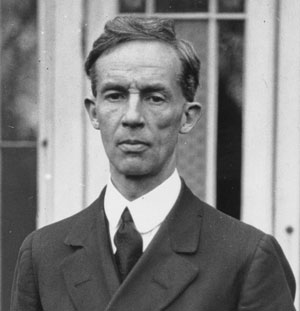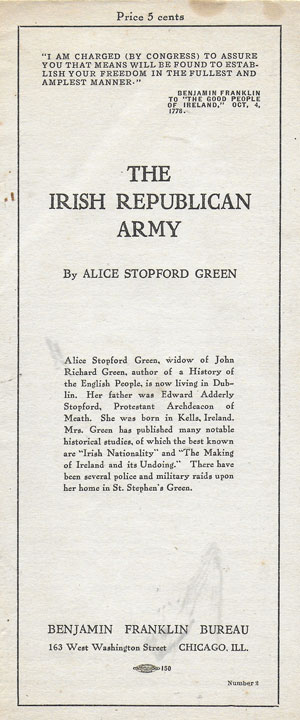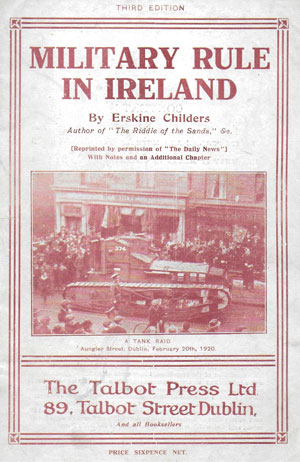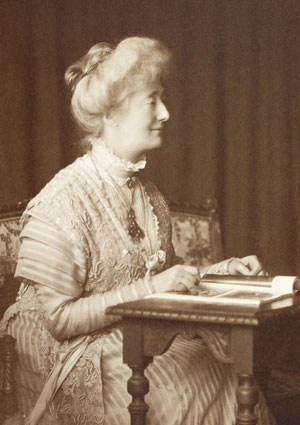PEACE, PARTITION AND THE REVOLUTIONARY MIND—THE INEFFABLE FRIENDSHIP OF ERSKINE CHILDERS AND ALICE STOPFORD GREEN
Published in Features, Issue 6 (November/December 2022), Volume 30By Angus Mitchell

Above and below: Why Erskine Childers and Alice Stopford Green have been so diminished within the narrative of Ireland’s War of Independence is a question worth asking.
On 24 November 1922, Erskine Childers—the renowned author and anti-Treaty republican—was executed by a military firing squad of the Irish Free State in Beggar’s Bush barracks. During the century since his tragic dénouement, various efforts have been made to explain Childers and ‘the metamorphosis of a stiff-upper-lip Boy’s Own novelist into a Sinn Féin martyr’. Indeed, Childers endures as an ineffable riddle in British–Irish studies. Various biographies have attempted to explain him away through psychological insights, personal flaws and the influence of Molly, his semi-invalid Bostonian wife. His incipient nationalist, socialist and anti-imperial sympathies have been ignored in favour of a focus on his underlying emotional complexities.
ERASURE
Biographical treatment has nudged Childers towards a position where he has become gradually inconsequential to the history of his time. A critical component of this steady erasure has required a diminishing of his political writings and the screening out of the logic of his transformation into a revolutionary. In recent years he has been readily dismissed as a ‘maverick’ and ‘outlier’, somehow unrepresentative of the struggles he supported.
Similar treatment has been applied to Alice Stopford Green, an unremembered historian of the Gaelic Revival. Stopford Green took an explicitly hostile line towards the historical establishment of her day. She argued that Ireland was the victim of a history that was better understood as a strategic technology developed to justify and protect the edifice of colonial authority in Ireland and its attendant ideologies. Recent scholarship exposing the complicity between history and empire would suggest that she had thoughts in advance of her time.
Why Childers and Stopford Green have been so diminished within the narrative of Ireland’s War of Independence is a question worth asking. Part of the answer is contained in Roy Foster’s reflection in his introduction to Paddy and Mr Punch (1995): ‘Britain and Ireland impinge on each other in a manner embarrassing to both: large areas are left unexplored by both sides, for reasons of bad conscience, good manners and convenient amnesia’. Here Foster hinted at that informal understanding among many professional historians that some areas of the past are better left alone and discreetly forgotten. This insight speaks to the enduring pressures between politics and history, a tension that becomes especially acute during commemorative intersections.
Stopford Green and Childers are remarkably absent from the intellectual history of the revolutionary generation. They are complex figures who are easily dismissed with that ‘convenient amnesia’ referred to above. Their shifting and multifaceted identities and loyalties have much to answer for. Both were deeply entwined with empire, and they had access to the very highest levels of power in London. Childers was a clerk in the House of Commons who served in both the Anglo-Boer War (1899–1902) and the First World War. Stopford Green was an old and close friend of Herbert Asquith, Edward Grey and Winston Churchill, and she was one of the most networked women of her day.
From liberal imperialist positions, they emerged along different paths to become fierce opponents of empire and military rule. Stopford Green’s condemnation extended from deeply held pacifist beliefs and her 1900 investigation of the condition of Boer farmers held as prisoners of war on St Helena (see History Ireland 14.4, July/August 2006, pp 19–24). Childers’s anti-imperial turn emerged much later.
THE PARTITIONING OF HISTORY
If their imperial pedigrees make them awkward to accommodate, so too does their shared objection to partition. Over the last century, the partition of Ireland has motivated a gradual division within the interpretation of the past to justify the border between north and south. By that process, some participants have been conveniently ‘disappeared’ from the narrative because their presence both undermines and transcends those agreed orthodoxies sustaining the dominant ‘two nations’ theory and the ‘inevitable’ process that led to partition. In that respect commemoration is revealing for how it has bolstered the dynamics of oblivion and erasure around those narratives and the people who challenge this consensus. Despite their friendship, Childers and Stopford Green ended up on different sides in 1922, and it is interesting to consider why that was, considering that they were so closely allied during the independence struggle.
The Irish Civil War was in essence a conflict about diametrically opposed views of Irish sovereignty. The 1916 Proclamation was a moment when sovereignty erupted from below. It was affirmed by the victory of Sinn Féin in the general election of 1918 and defined by the assertions of the Dáil in 1919, notably the Declaration of Independence and the Democratic Programme. The collective effort to defend sovereignty over the next few years was met with increasing levels of British military aggression. By 1920 Ireland was governed by a particularly ruthless axis embodied in the figures of Sir John French, Walter Long and General Neville Macready. With the introduction of the Black and Tans and Auxiliaries to supplement the RIC, Britain sought to use superior force to annihilate Sinn Féin. Those tactics failed. At the end of the year, the Government of Ireland Act was passed through parliament in the absence of almost any democratically elected Irish representative. A war of reprisals led to Britain losing all vestiges of moral authority. However, the sovereignty imposed on Ireland in 1921 with the Articles of Agreement was a form of imperial sovereignty—sovereignty bequeathed from above. That is why the Anglo-Irish Treaty could be signed by Lloyd George, Lord Birkenhead and Churchill: all devout imperialists.
THE FRIENDSHIP BETWEEN CHILDERS AND ALICE STOPFORD GREEN

Above: Alice Stopford Green supported Sinn Féin at its foundation in 1905. The publication in 1921 of her pamphlet ‘The Irish Republican Army’ republished her attack on the Trinity College, Dublin, historian Walter Alison Philipps.

Above: Erskine Childers’s Military rule in Ireland was unmuzzled in its condemnation of the structure of violence adopted by British military authorities in Ireland.
In the historiography of the War of Independence, the group that has fared worst in the interpretation of that moment are those intellectuals who supported the independence movement and were perceived as ‘Anglo-Irish’ or ‘Protestant Nationalists’—both awkward labels. Their participation unsettles the argument that the War of Independence should be understood in terms of Catholic and Protestant differences and the sectarian divide.
Despite their Irish upbringings and affinities, Stopford Green and Childers were esteemed public intellectuals in the London of the early twentieth century. Their world-views accommodated liberal imperialist and moderate Irish nationalist outlooks. Childers’s best-selling spy novel The riddle of the sands and Stopford Green’s popular histories turned them both into metropolitan celebrities. Between 1911 and 1922 they nurtured a friendship that was initiated when Molly and Erskine were invited to dine with Stopford Green at her Westminster house in December 1911, an occasion inspired apparently by her reading of Childers’s book The framework of Home Rule.
In January 1912, Stopford Green and other prominent Irish Home Rulers, notably Dr Sophie Bryant, Mary Spring Rice and Robert Lynd, gathered for a two-day conference held at the London School of Economics to discuss questions of Irish Home Rule, finance and fiscal autonomy. The economist John Maynard Keynes was also present. In May, Stopford Green attended a lecture by Childers presided over by their mutual friend Arthur Conan Doyle. The following year they were part of a small group who formed the Dublin Distress Fund to raise money to help feed, clothe and house women and children during the 1913 Lockout. Other supporters of this humanitarian intervention included the historian G.M. Trevelyan, W.B. Yeats and the Congo reform campaigner E.D. Morel.
The moment that binds Stopford Green and Childers together most intimately is their close collaboration in planning and executing the Howth and Kilcoole gunrunning in July 1914. Beyond the symbolic value of that moment in terms of the arming of the Irish Volunteers, it is equally significant owing to the involvement of a group of like-minded moderate Home Rule nationalists from Anglo-Protestant backgrounds.
In the aftermath of the Easter Rising, both Childers and Stopford Green started to co-operate in different ways to find a settlement. In 1917 Childers became secretary to the Irish Convention for the British delegation. Stopford Green worked behind the scenes for the Irish negotiators. Following the Treaty of Versailles, and the hostile exclusion of Ireland from the talks, Childers’s republicanism started to emerge as he questioned the use of military rule and force in maintaining law and order. Stopford Green was always motivated more by her pacifism and an instinctive abhorrence of violence. Her homes in London and Dublin during these years became hubs of national revolutionary dialogue.
From 1919, as the confrontation between the IRA and the British military authorities escalated, they assumed important roles in the background to conflict. The recently published memoir of Máire Comerford provides fascinating details on this dimension. Following their relocation to Dublin, Childers and Stopford Green were active in the production and dissemination of propaganda through their work distributing the Irish Bulletin and preparing Ireland for independence, even if the nature of that transition remained uncertain. Their collaboration continued in shared endeavours such as Cumann Léigheacht an Phobail, an educational initiative founded to organise lectures and distribute pamphlets to Sinn Féin clubs across Ireland.
At the end of 1920 they collaborated with others in establishing the Peace with Ireland Council (PIC), set up by the historian Basil Williams, a close friend of Childers from Anglo-Boer War days. Over nine months, the PIC aroused widespread support in England for Irish independence by exposing the brutal nature of the campaign of reprisals. The PIC successfully challenged the moral authority of Lloyd George’s coalition. The success of the movement extended from its capacity to galvanise the women’s movement along with leading churchmen and the Labour Party into a common front of opposition. A statement by George Berkeley, a key organiser involved in this association, is available on open access in the archive of the Bureau of Military History.
On St Brigid’s Day 1921, Childers and Stopford Green were both present at the inaugural meeting of the Irish White Cross (IWC), held in private at the Mansion House. Established as a purely humanitarian initiative, the IWC sought to distribute American funds to areas of the 32 counties hit hardest by war. It was an ecumenical and all-party alliance. The list of names of trustees and the committee was widely circulated in newspapers. The combination of the work of the PIC and the IWC built an extensive support network in Britain and the US advocating for an end to the war. A large demonstration in London at the start of July 1921 confirmed widespread solidarity in Britain for peace in Ireland. A few days later, the terms of the truce were typed out in the Dublin house of Stopford Green, after which she hurried to London to welcome the Irish peace delegates at Euston station. That delegation included Erskine Childers, who would play a key advisory role in the negotiations that ended with the signing of the Anglo-Irish Treaty. His closest friends, however, found it hard to accept that though he had played such a supportive role in the background to the Treaty negotiations he decided to take the anti-Treaty side during the Civil War.
THE SPLIT
Throughout the decade 1912–22, the Childers and Stopford Green axis was a crucial conveyor of liberal, nationalist, imperial and revolutionary dialogue. Their friendship provides insight into the personal and political struggles faced by those whose loyalties were split between Britain, Ireland and a broader care for humanity. They came to reject the racist and class divisions of empire and, most defiantly, the dynamic of imperial authority that the historian Caroline Elkins has recently termed ‘legalized lawlessness’.
In the last surviving letter from Childers to Stopford Green, dated 25 May 1922, he agreed that those who had chosen peace had made a ‘noble’ choice, but he felt that his decision to continue to defend the ‘revolutionary mind’ was no less noble, even though a ‘chasm’ now separated those who were once united in the common fight for Irish freedom. Childers refused to compromise. He never wavered from the view that the sovereignty delivered under the Treaty was an imperial solution to an anti-imperial problem.
Childers was executed on trumped-up charges of possessing a gun gifted by Michael Collins. A month later Stopford Green was one of four women to take up a seat in Seanad Éireann. She would die of natural causes in May 1929 and was buried on her 82nd birthday in Deans Grange Cemetery. Both went to their graves believing that partition was not the inevitable end to the Irish problem but an aberration, an instrument of imperial control in an Ireland that could and should accommodate difference. Although she wrote perceptive and personal obituaries of both Michael Collins and Arthur Griffith, Stopford Green did not make any public statement about the execution of Childers. Her silence is hard to read.
Understanding the connections and collaborations between Stopford Green and Childers, and the differences that eventually set them on conflicting paths, can offer nuanced insights into the intricacies of alternative formations of intellectual engagement during the transition of Ireland’s independence struggle into civil war. A prevalent contemporary argument supporting partition is contingent on the view that Catholic nationalists and the IRA were sectarian, anti-Protestant and Anglophobic. That position depends on the purging of participants who up-end such positions and whose inclusion might incite a more informed perspective of Ireland’s entanglement with the British Empire.
Angus Mitchell is an independent historian.
Further reading
F.X. Martin (ed.), The Howth gun-running 1914 (Dublin, 1964).
B.P. Murphy, ‘Erskine Childers: the evolution of an enemy of Empire’, in E. Flannery & A. Mitchell (eds), Enemies of Empire: new perspectives on imperialism, literature and historiography (Dublin, 2008).
Angus Mitchell will deliver a lecture on the ‘Peace with Ireland Council’ in Dublin City University (venue TBC) at 5.30pm on 22 November 2022 under the auspices of DCU’s Centre for Religion, Human Values, and International Relations, https://www.dcu.ie/religionandhumanvalues.

















